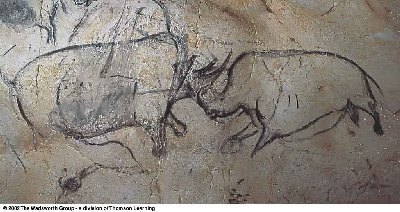Terms / Concepts / Features
- ethnographic analogy
- shaman / shamanism (angokok)
- shamanistic rituals relate mostly to hunting
- "parallel worlds"
- men, animals and spirits have always been one
- in shamanistic societies people often believe in the
idea of "parallel worlds"
- the shaman enters the parallel worlds to obtain power
- the underground world was seen as the spirits, the world
of the supernatural
- in the depth of the cave the shaman would enter the
parallel world
- the shaman would go into trance
- shamanistic trance was the bridge between the conscious
and unscious worlds
- !Kung San shamanistic rituals
are part of everyday life
- for the Inuit every part of the animal has a purpose
- place names
- "moderns" arrived in Europe 35,000 - 40,000
ybp
- we begin to see evidence in terms of things like cave painting
- they were beginnning to enter the wold of the supernatural
- salon noir -- the black room (chamber)
- we have composit figurines, half-animal, half-human
- "fossil words"
- tend to be stable core words
- first and second person pronouns
- body parts
- natural phenomena
- Merritt Ruhlen
- the world has about 5000 languages, divided into 400
families and 12 major groups
- words go back 40,000 to 50,000 ybp in Africa
- "the genealogy of Y-chromosomes"
- are present only in males
- are inherited father to son
- "genetic variation in humans today"
- Mousterian
- Upper Paleolithic
(Upper "Old Stone Age")
- population growth
- personal ornamentation
- art
- language / linguistics
- tradition
Notes
- As you watch this video compare its contents with "Ethnoarchaeology
and Ethnographic Analogy" from Ch. 14 of the textbook
- Use the dates on the "Times to
Remember" WebPage
- ca. 95,000 ybp a woman's skull
was buried with a child
- "Economics, social organization, arts, religion, burial
customs, they all existed in some form in 'The Stone Age' [the
Paleolithic]
and they still exist today."
- Note items of personal adornment and the social networks
they represent
- the oldest burial with an offering comes from ca.
100,000 ybp
- Note cave art
- ". . . intiuition is linked to knowledge, knowledge
to mind, and mind to language."
- "In short, we have entered a world where thought permeats
everything, and this certainly is one of the legacies of Homo
sapiens."
Cultures
- Inuit (Siberian North America)
- Homo sapiens
- San (Khoisan; !Kung; "Bushmen";
Tsuntwasi)
- y-chromosomes
- chromosomes are oldest with the San "Bushmen"
of Botswana and Namibia
Sites
- Canadian Arctic
- St. Petersburg, Russia
- Siberian Peoples
- Film Theatre of the Museum of the Russian People
- "With antlers and bones you can make all sorts
of things"
- southern France
- U.S.A.
- Middle East
- Africa
- "Bushmen (Khoisan; !Kung; "Bushmen";
Tsuntwasi) Today"
Individuals
- D’Anglure, Bernard Saladin (ethnologist)
- Gorbatcheva, Valentina (ethnologist)
- Museum of the Russian People
- Vassilév, Sergei (archaeologist)
- Clottes, Jean (prehistorian)
- France
- expert on prehistory
- Ruhlen, Merritt (linguist)
- studying the origin of language
- Vandermeersch, Bernard (anthropologist)
- Mideast
- Israel
- oldest burial offering that we know
- Bruiel, L'abbe
- Hammer, Michael (geneticist)
- Wiessner, Polly (ethnologist / ethnoarchaeologist)
- African !Kung San peoples
E-mail Address
Question(s)
- "Where did Homo sapiens come from?"
- "How did they interpret their world?"
- "And what did they think and feel?"
- Were they anything like us?
|


